Coin mechanisms have evolved from simple mechanical slots that rely on size and weight to advanced digital validators using sensors and microprocessors. These modern systems quickly verify coin authenticity, detect counterfeits, and handle transactions seamlessly. Mechanical methods focus on durability and simplicity, while digital validators improve accuracy and security. If you’re curious about how these innovations continue shaping payment technology, you’ll find plenty more insights ahead.
Key Takeaways
- Early mechanical coin mechanisms relied on size, weight, and shape recognition using levers, springs, and metal plates for validation.
- Mechanical validators incorporated intricate lever systems, tunnels, and spring-loaded arms to test coin authenticity and durability.
- Transition to electronic systems introduced sensors, advanced software, and user interfaces, enabling faster and more accurate coin recognition.
- Digital validators utilize contactless, biometric, and AI-driven technologies for enhanced security and counterfeit detection.
- The evolution reflects a shift from physical, mechanical components to sophisticated, integrated digital systems improving speed, security, and reliability.
Early Mechanical Coin Slots and Their Design

Have you ever wondered how the earliest mechanical coin slots worked? These devices showcase impressive historical craftsmanship and clever mechanical design. Early coin slots relied on simple yet effective mechanisms that recognized and accepted coins through physical features like size and weight. Inside, tiny levers and springs interacted with the coin, ensuring only valid currency triggered the mechanism. The craftsmanship involved precise metalwork, with artisans carefully shaping components to fit perfectly. This mechanical design eliminated the need for electronic parts, making these coin slots reliable and durable. Each part served a specific purpose, from guiding coins to activating the payout or lock system. Additionally, the design principles of these early coin slots influenced modern entertainment and parks security features. These early designs laid the foundational principles that would evolve into more sophisticated coin validation technologies later on.
The Rise of Mechanical Coin Validators and Their Mechanisms
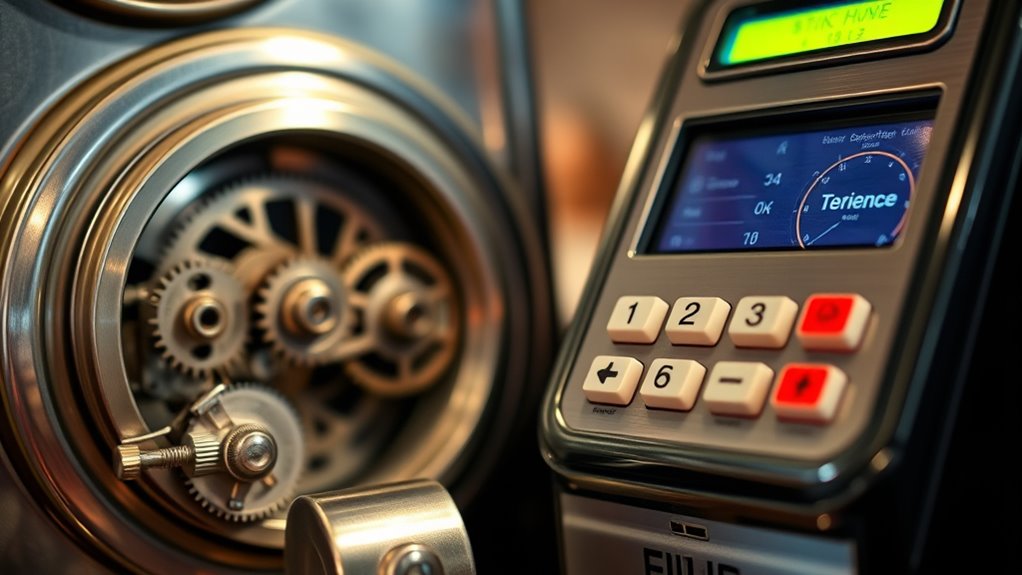
As coin-operated machines became more popular, engineers developed mechanical validators that could reliably distinguish genuine coins from counterfeits. These historical coin mechanisms used intricate systems of levers, weights, and tunnels to verify authenticity. Their mechanical reliability assured consistent performance, earning trust from operators and users alike. You can imagine:
- Precise slots calibrated to specific coin diameters and thicknesses
- Spring-loaded arms that tested coin weight and shape
- Tunnels with metal plates that checked for electrical conductivity
- The use of sound waves to influence brainwave patterns, which is a principle also explored in sound healing science.
These mechanisms relied on physical properties, making them effective before digital recognition. Their design emphasized durability and simplicity, allowing widespread adoption in vending machines, laundries, and arcades. This era marked a significant step in automating transactions with reliable, purely mechanical solutions.
Transition to Electronic Coin Recognition Systems
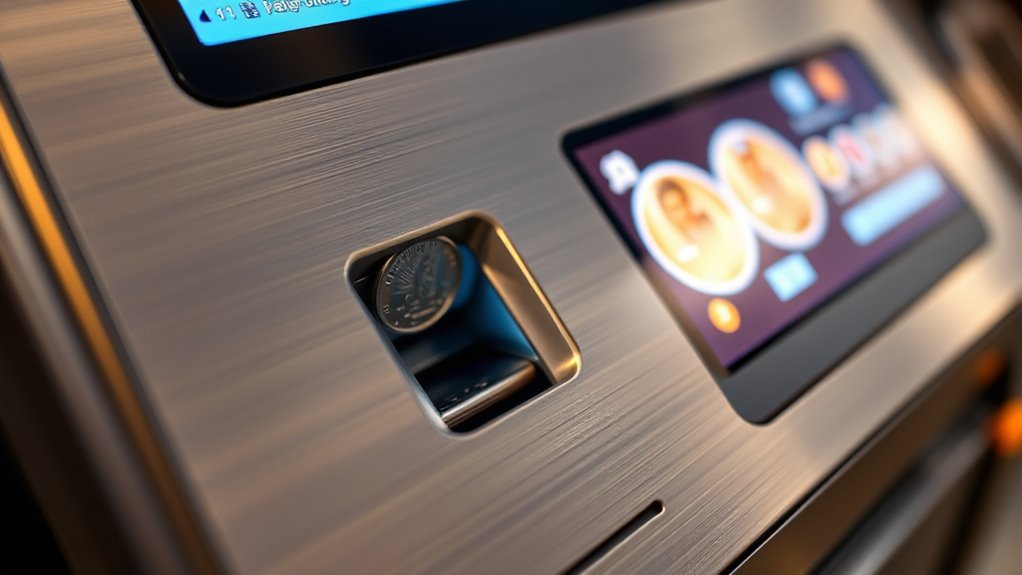
As you move toward electronic coin recognition systems, you’ll notice how advanced technologies improve accuracy and reliability. However, shift isn’t without its challenges, like adapting existing machines and ensuring consistent performance. Understanding these factors helps you grasp how this change impacts coin validation processes. Additionally, automation in business plays a role in streamlining the adaptation process, leading to more efficient implementation and maintenance of these new systems.
Electronic Recognition Technologies
Why are electronic recognition technologies revolutionizing coin validation? They enable faster, more accurate identification of coins, reducing errors and delays. These systems utilize advanced sensors and software to detect counterfeit coins, ensuring only genuine currency gets accepted. You’ll notice a user interface that’s intuitive, guiding users seamlessly through the process. Imagine:
- Bright LED indicators signaling acceptance or rejection instantly
- Touchscreen displays showing clear instructions and feedback
- Compact units fitting into tight spaces without sacrificing performance
- Color accuracy plays a role in how well the device’s display communicates status and instructions clearly. These innovations make coin validation more reliable and efficient. Electronic recognition systems also minimize manual checks, enhance security, and streamline operations. By combining sophisticated counterfeit detection with user-friendly interfaces, they transform how coins are validated in vending machines, kiosks, and other devices.
Accuracy and Reliability
Electronic coin recognition systems substantially improve accuracy and reliability by precisely verifying coin authenticity in real-time. They excel at counterfeit detection, quickly identifying fake coins through advanced sensors and algorithms. These systems use calibration techniques to maintain consistent performance, ensuring recognition accuracy over time despite environmental changes or wear. By continuously calibrating sensors, you minimize errors caused by dirt, corrosion, or slight variations in coin size and weight. Incorporating advanced technology enhances the system’s dependability and reduces false declines or acceptances. The combination of sophisticated counterfeit detection and robust calibration techniques makes electronic coin recognition systems highly reliable. As a result, you can trust these systems to accurately validate coins, leading to smoother transactions and increased confidence in automated currency handling.
Transition Challenges
Moving to electronic coin recognition systems presents several challenges that need careful management. One major concern is maintaining effective counterfeit prevention, ensuring fake coins don’t slip through the system. You also face the task of implementing robust user authentication to prevent unauthorized access. As you upgrade, imagine:
- Fine-tuning sensors to detect subtle differences in coin materials
- Developing secure algorithms to verify coin authenticity in real time
- Educating staff and users about new procedures to reduce errors
These hurdles require precise calibration and constant updates. Without proper focus on counterfeit prevention and user authentication, the system’s integrity could be compromised. Successfully navigating these challenges will lead to a smoother transition and a more secure, reliable coin recognition process.
The Advent of Digital Payment Validation Technologies
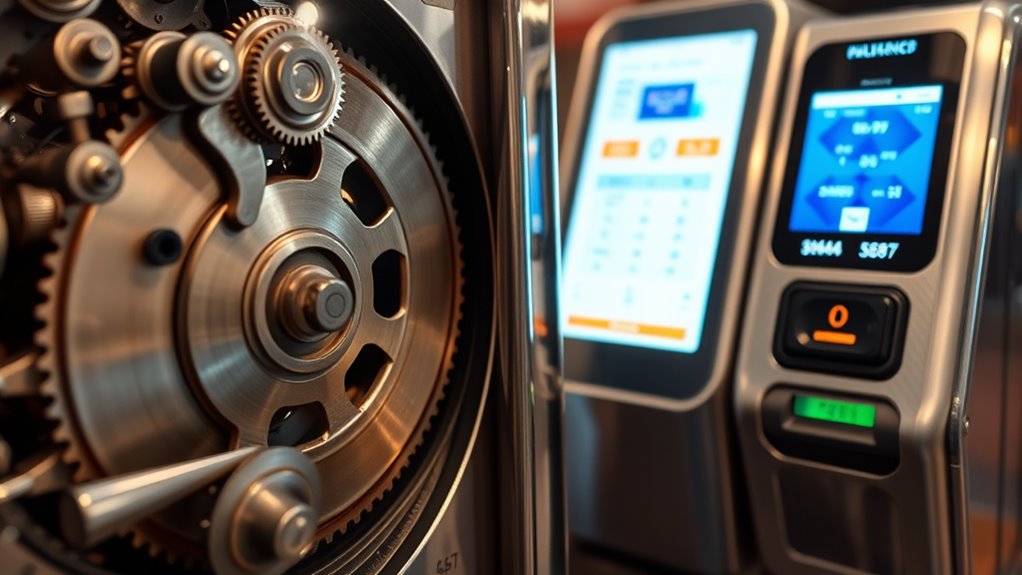
Digital payment validation technologies have revolutionized the way transactions are authorized and secured, making cashless payments faster and more reliable. You now benefit from advanced systems that quickly verify digital credentials, reducing fraud risks. These innovations also enhance counterfeit prevention by integrating sophisticated encryption and authentication protocols. Coin material technology advances further support secure validation, ensuring physical coins are harder to counterfeit and easier to authenticate electronically.
| Technology Aspect | Benefits |
|---|---|
| Digital Validation | Speed, convenience, reduced fraud |
| Material Tech | Enhanced security, durability |
| Counterfeit Prevention | Improved authenticity verification |
| Reliability | Consistent, tamper-proof transactions |
Integration of Sensors and Microprocessors in Coin Handling
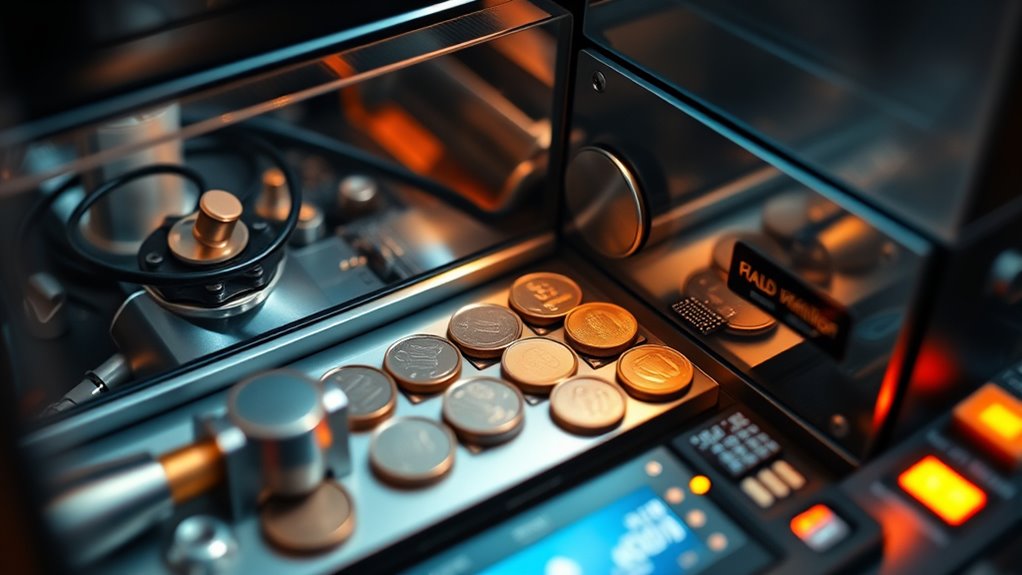
Integrating sensors and microprocessors into coin handling systems considerably enhances their accuracy and efficiency. With sensor integration, you can precisely detect coin size, weight, and metallic composition, reducing jams and false acceptances. Microprocessor applications enable real-time data processing, allowing swift validation and sorting of coins. Imagine:
- Sensors that instantly identify counterfeit coins through material analysis
- Microprocessors that adapt to different coin types without manual adjustments
- Automated systems that quickly sort and route valid coins to storage or collection points
- Enhanced reliability through continuous system monitoring and diagnostics, reducing downtime and maintenance needs
These advancements streamline operations, minimize errors, and improve user experience. By combining sensor integration with microprocessors, your coin mechanisms become smarter, faster, and more reliable—paving the way for seamless, automated coin handling solutions.
The Shift Toward Contactless and Digital Payment Methods
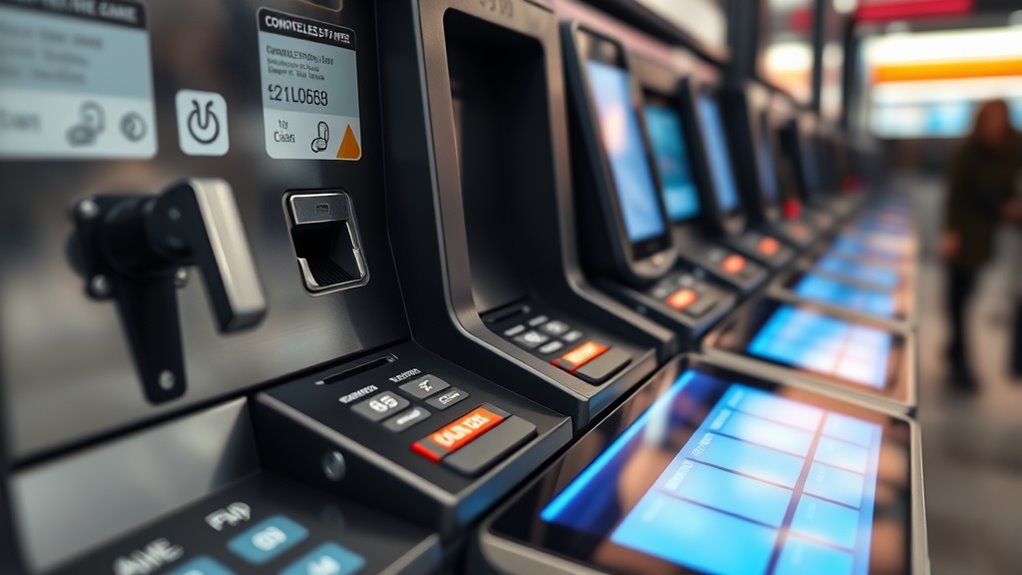
You’re likely noticing more stores accepting contactless payments through cards and smartphones. As digital wallet adoption grows, security becomes a key concern for users and providers alike. Exploring how these technologies are transforming transactions reveals both opportunities and challenges ahead. For instance, Pimple Patch technology demonstrates how targeted, non-invasive solutions can improve skin health efficiently, paralleling how digital payments aim to enhance transaction security and convenience.
Contactless Payment Technologies
Have you noticed how contactless payment methods are transforming the way we shop and pay? You can now breeze through checkout lines with a simple tap or wave, making transactions faster and more convenient. These technologies leverage secure chips and sensors to guarantee authenticity, including counterfeit detection to prevent fraud. Modern systems also streamline coin sorting, replacing physical cash with digital signals that reduce errors. Imagine your payment being verified instantly as your card or device communicates wirelessly with the terminal. You might see:
- Fast, seamless transactions without fumbling for cash
- Advanced sensors verifying card authenticity
- Reduced handling of physical coins and bills
- The integration of angel number recognition in some systems to provide personalized alerts and messages.
These innovations are making payments safer and more efficient, shifting focus from mechanical coin mechanisms to sophisticated digital validators.
Digital Wallet Adoption
As more consumers embrace contactless and digital payment methods, digital wallets have become a key driver of this shift. They offer seamless transactions, often integrating features like cryptocurrency support and biometric authentication for enhanced convenience. You can now pay with a tap or scan, reducing reliance on cash or cards. This widespread adoption is fueled by the rise of smartphone use and evolving security standards. Digital wallets also enable quick access to your funds and crypto assets, making financial management easier.
| Feature | Benefit | Example |
|---|---|---|
| Cryptocurrency Integration | Access to crypto assets within wallets | Buying goods with Bitcoin |
| Biometric Authentication | Secure, fast access to funds | Unlocking with fingerprint |
| Contactless Payments | Quick, cashless transactions | Tap your phone at checkout |
Security in Digital Payments
While digital payment methods offer unmatched convenience, they also introduce new security challenges that you must navigate. Fraudsters constantly attempt counterfeiting, making counterfeit prevention a top priority. You need robust user authentication to guarantee you’re the only one accessing your funds. Imagine:
- Scanning biometric data or entering PINs to verify your identity
- Digital signatures and encryption protecting your transaction data
- Real-time alerts alerting you to suspicious activity
These measures help prevent counterfeit copies of digital cards and authenticate your identity securely. As contactless and mobile payments grow, understanding these security layers becomes essential. Staying vigilant and leveraging strong authentication methods keeps your digital transactions safe and trustworthy. Incorporating vertical storage solutions and decluttering techniques can also help manage physical security by reducing clutter that may impede access to secure areas or devices.
Comparing Mechanical and Digital Validation Accuracy

When comparing mechanical and digital validation accuracy in coin mechanisms, it becomes clear that digital systems generally offer higher precision and consistency. Digital validators excel at detecting counterfeit coins through advanced sensors and software, reducing false acceptances and rejections. They also improve user authentication by verifying coin authenticity quickly and accurately, ensuring only valid currency is accepted. Mechanical mechanisms rely on physical features like size and weight, which can be less reliable over time due to wear and tear. Digital systems adapt more easily to coin variations and can be calibrated regularly for ideal accuracy. This results in fewer errors, faster processing, and enhanced security against counterfeit attempts. Overall, digital validators provide a more dependable and precise validation process compared to traditional mechanical systems. Incorporating cybersecurity vulnerabilities considerations into these systems further enhances their robustness and trustworthiness.
Benefits and Challenges of Modern Digital Coin Validators
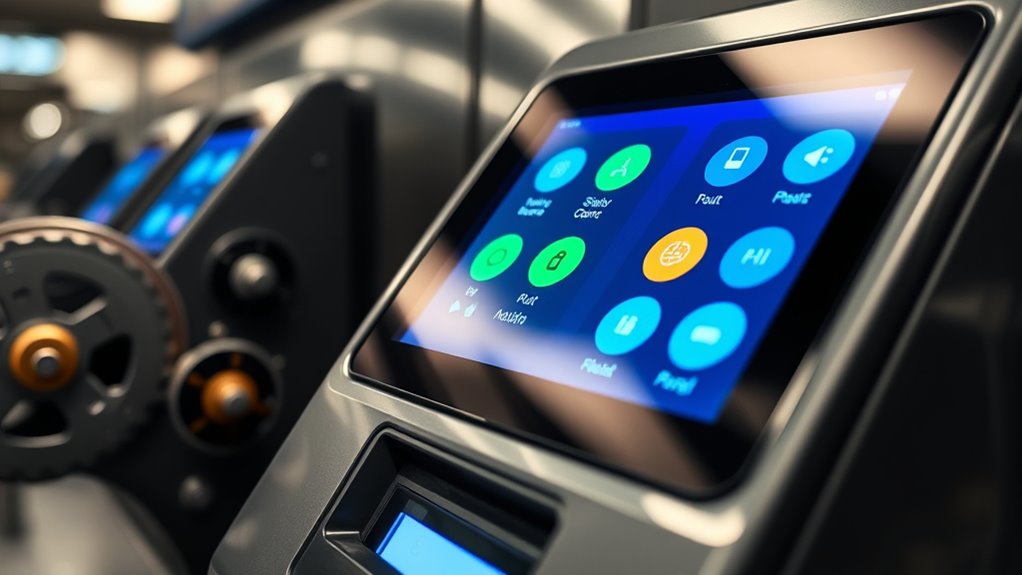
Modern digital coin validators offer significant advantages over traditional mechanical systems, making them increasingly popular in various settings. They streamline transactions, enhance security, and support cryptocurrency integration, allowing seamless digital and crypto payments. However, challenges exist, such as high initial costs, maintenance complexity, and potential cybersecurity risks. You might imagine:
- A sleek device scanning your biometric authentication fingerprint for quick access
- Digital screens displaying real-time transaction data and cryptocurrency options
- Secure connections protecting against hacking attempts and data breaches
While these validators improve efficiency and security, you must also consider technical issues and the need for ongoing updates to stay ahead of cybersecurity threats. Balancing these benefits and challenges ensures you maximize the potential of modern coin validation technology.
Future Innovations in Currency Validation Technologies
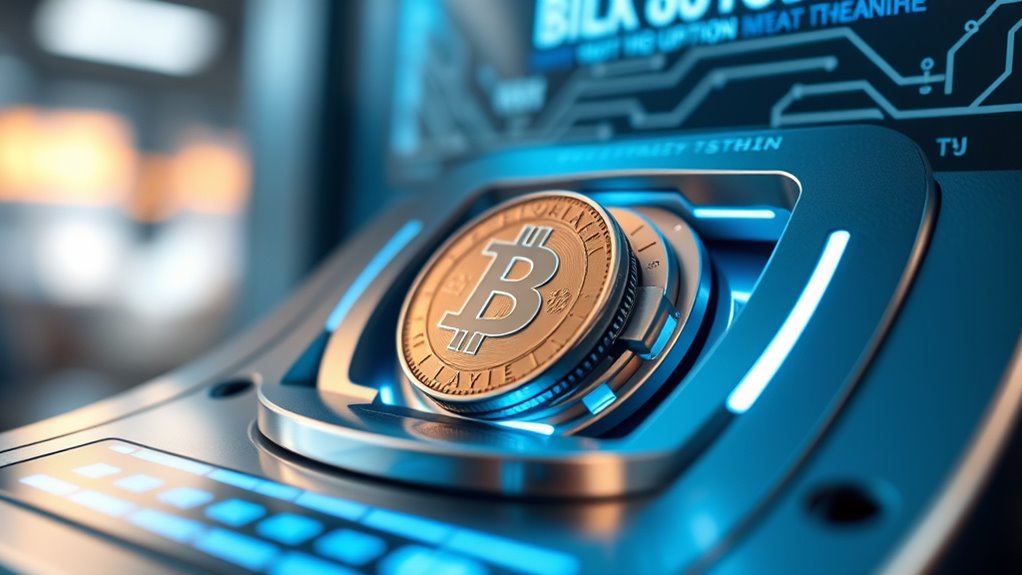
Advancements in currency validation technologies are set to revolutionize how transactions are conducted, integrating cutting-edge features that increase speed, security, and user convenience. Future innovations may incorporate biometric authentication or AI-driven fraud detection, making validations more reliable. As we move beyond traditional methods, understanding the role of historical coinage remains important, as it reflects cultural symbolism and societal values. New validation systems could preserve these symbols digitally, allowing for more meaningful connections to currency’s origins. Enhanced security measures will protect against counterfeiting while maintaining the cultural significance embedded in certain designs. These innovations will not only streamline transactions but also deepen appreciation for currency’s historical and cultural contexts, ensuring that as technology advances, it respects and preserves the legacy of coinage.
Impact of Digital Validation on Global Payment Infrastructure
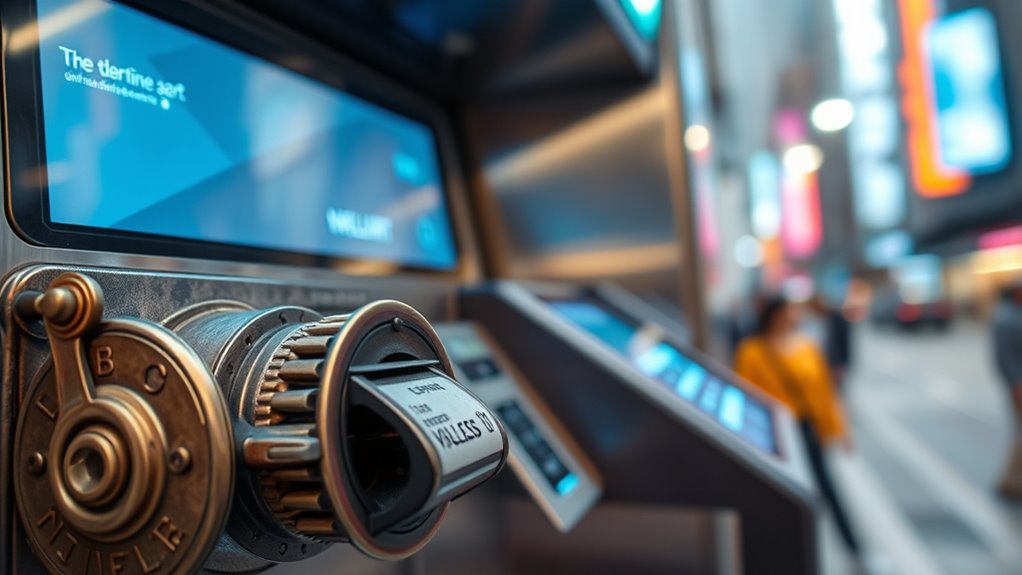
Digital validation technologies are transforming the global payment landscape by enabling faster, more secure transactions across borders. These innovations improve counterfeit detection, reducing fraud and increasing trust in digital currencies. They also streamline coin sorting processes, making payment systems more efficient and reliable. As a result, you’ll experience quicker transaction times and enhanced security measures. Imagine:
- Automated systems instantly verifying currency authenticity
- Digital validators seamlessly processing cross-border payments
- Reduced manual coin sorting leading to fewer errors and delays
These advancements reshape how financial institutions and consumers interact, fostering a more resilient and inclusive payment infrastructure worldwide. Digital validation not only accelerates transactions but also elevates the security standards necessary for a modern, interconnected economy.
Frequently Asked Questions
How Do Digital Coin Validators Handle Counterfeit or Damaged Coins?
Digital coin validators handle counterfeit and damaged coins through advanced systems that perform real-time counterfeit detection and damage assessment. You’re likely to see sensors and optical scanners that analyze coin features, ensuring authenticity and integrity. If a coin is damaged or suspected counterfeit, the system rejects it, preventing fraud and maintaining fair transactions. This process makes digital validators more reliable and efficient compared to traditional mechanical methods.
What Security Features Are Integrated Into Modern Digital Payment Validators?
You’ll find that modern digital payment validators incorporate advanced security features to keep transactions safe. They use cryptographic protocols to encrypt data, making it difficult for unauthorized parties to access sensitive information. Additionally, robust user authentication guarantees only authorized users operate the device, adding an extra layer of protection. These measures work together seamlessly, providing a secure and trustworthy experience, much like a well-guarded vault quietly safeguarding valuable assets.
How Do Digital Systems Affect Transaction Speed Compared to Mechanical Methods?
Digital systems markedly boost transaction speed compared to mechanical methods by enhancing digital validation efficiency. You’ll notice faster processing times, reducing wait periods and improving overall cryptocurrency scalability. Unlike mechanical validators, digital validators handle multiple transactions simultaneously, making them more reliable and efficient. This rapid processing enables smoother, more scalable payment systems, allowing you to complete transactions quickly while maintaining security and accuracy in a digital environment.
Are Digital Coin Validators Compatible With Multiple Currencies Worldwide?
You’ll be amazed at how digital coin validators can handle multiple currencies worldwide, making your transactions smoother than ever. They offer multi-currency support and seamless currency conversion, so you don’t need separate machines for each money type. This flexibility saves time, reduces errors, and simplifies operations, fundamentally revolutionizing how you manage international transactions and making global commerce faster and more efficient than you ever thought possible.
What Environmental Impacts Are Associated With Transitioning to Digital Coin Validation?
When you consider the environmental impacts of shifting to digital coin validation, you should focus on energy consumption and electronic waste. Digital validators often require significant electricity, contributing to higher carbon footprints. Additionally, as devices become obsolete, electronic waste accumulates, posing disposal challenges. You might find that while digital systems improve efficiency, they also demand responsible energy use and recycling practices to minimize environmental harm.
Conclusion
As you see, coin validation has come a long way, but the journey isn’t over yet. Future innovations promise even smarter, faster, more secure systems—what’s next could change how you pay forever. Will digital validators fully replace mechanical ones? Or will a new, unexpected technology emerge? Stay tuned, because the evolution of currency validation is far from finished, and you’re right at the edge of this exciting revolution.








